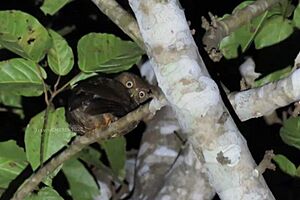Camiguin boobook facts for kids
Quick facts for kids Camiguin hawk-owl |
|
|---|---|
 |
|
| Conservation status | |
| Scientific classification | |
| Genus: |
Ninox
|
| Species: |
leventisi
|
The Camiguin hawk-owl (Ninox leventisi) is a special type of owl. It lives only on Camiguin island in the Philippines. This owl is unique because it's the only one in the Philippines with greenish-yellow or grayish eyes. People on Camiguin island call it kugkug.
Scientists used to think this owl was just a type of Philippine hawk-owl. But in 2012, they found out it was its own species. They learned this by listening to its calls and looking at other clues.
What Does It Look Like?
The Camiguin hawk-owl is a medium-sized owl. It has a brown head and brown upper body. Its underside is a warmer brown color. It has long "whiskers" around its face. A pale bar can be seen behind its shoulder.
One of its most striking features is its eyes. They are a bright greenish-yellow. Other owls in its family usually have yellow or reddish-brown eyes. It also has a noticeable white patch on its throat. This patch is easy to see when the owl is calling.
This owl makes a rapid series of low "woop" sounds. Sometimes, two owls will call back and forth to each other.
The Camiguin hawk-owl is one of the larger owls in its group. It can grow up to 25 centimeters (about 10 inches) tall. Other related owls, like the Luzon boobook or Mindanao boobook, are smaller. They are usually 15 to 20 centimeters (6 to 8 inches) tall.
Where Does It Live and Is It Safe?
This owl lives in tropical forests on Camiguin Island. It prefers moist lowland primary (old growth) and secondary forests. You can find it up to 700 meters (about 2,300 feet) above sea level. Sometimes, it is also seen at the edge of forests. It can even be found in clearings or plantations.
The IUCN Red List says this bird is "vulnerable." This means it is at risk of becoming endangered. There are only about 250 to 999 adult owls left.
The biggest danger to the Camiguin hawk-owl is habitat loss. This means its forest home is disappearing. People are cutting down trees for legal and illegal logging. Land is also cleared for mining and farms. This happens through methods like Slash-and-burn farming. More buildings are also being built as more tourists visit the island. All these changes force the owls to move to higher, smaller forest areas.
Right now, there are no special programs just for this owl. But people are suggesting ways to help. They want to do more surveys to learn about the owl's habitat and how many are left. They also want to teach local people about the owl. This can help people feel proud of this unique bird. Protecting the remaining forests is also very important.


